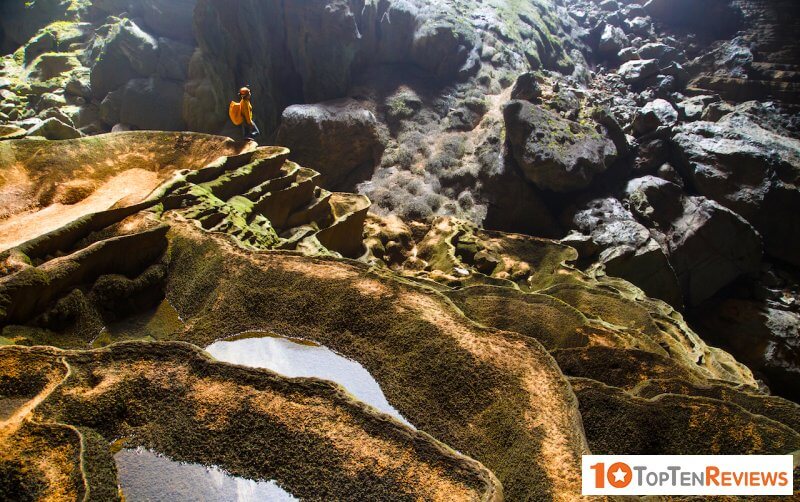Formed about 2-5 million years ago, Son Doong Cave has a width of 150m, a height of more than 200m, a length of up to nearly 9km. The estimated capacity of Hang Son Doong is 38.5 million cubic meters.
With such size, Son Doong cave has surpassed Deer cave in Gunung Mulu National Park of Malaysia (with a height of 100m, width of 90m, length of 2km) to occupy the position of the largest natural cave in the world.
Son Doong Cave has coordinated 17°27'25.88″North 106°17'15.36″East, located in Son Trach commune, Bo Trach district, Quang Binh province, located in the Phong Nha-Ke Bang cave complex.
Geoscientists in the world consider Son Doong to be the most magnificent cave in the world.
Son Doong Cave is considered a "monumental, wonderful" picture with many stalactites with strange shapes. The most memorable thing is that there is a primeval forest growing in the cave. Geoscientists in the world consider Son Doong to be the most magnificent cave in the world.
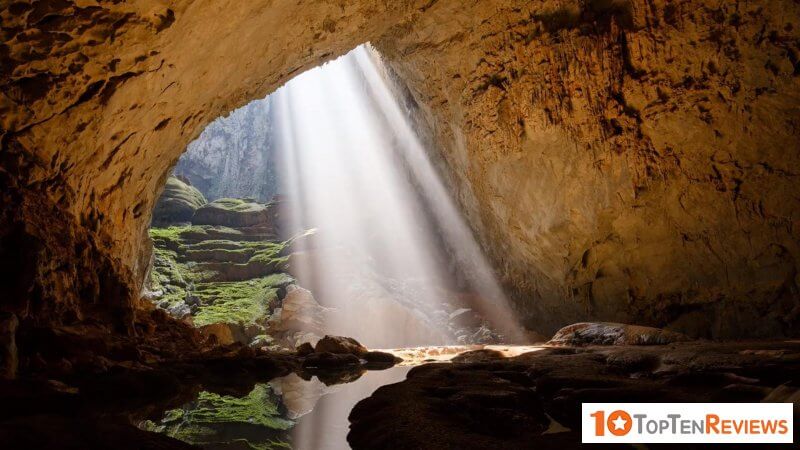
Also Known As
- Afrikaans: Son Doong
- Albanian: Shpella e Son Doong
- Albanian: Sơn Đoòng
- Arabic: سون دونغ
- Arabic: كهف شاندونغ
- Aragonese: Son Doong
- Armenian: Շոնդոնգ
- Asturian: Cueva Son Doong
- Azerbaijani: Şondonq mağarası
- Basque: Son Doong
- Belarusian: Шандонг
- Bengali: হ্যাংসন ডুং
- Bulgarian: Шондонг
- Catalan: Son Doong
- Chinese: 山水洞
- Chinese: 韩松洞
- Croatian: Son Doong
- Croatian: Sơn Đoòng
- Czech: Son Doong
- Danish: Son Doong
- Dutch: Hang Son Doong
- Dutch: Hang Sơn Đoòng
- Egyptian Arabic: شنق سن اونج
- English: Hang Sơn Đoòng
- Esperanto: Kaverno Son Doong
- Estonian: Son Doong
- Estonian: Sơn Đoòng
- Estonian: Sơn Đoòngi koobas
- Finnish: Sơn Đoòng
- French: Grotte Hang Son Doong
- French: Grotte Hãng Sơn Đông
- French: Grotte Son Doong
- French: Grotte Son Dông
- French: Grotte Sơn Đoòng
- French: Grotte Sơn Đông
- French: Hang Son Doong
- French: grotte Sơn Đông
- Galician: Cova de Son Doong
- Georgian: შონდონგი
- German: Hang Son Dong
- German: Son-Doong-Höhle
- German: Sơn-Đoòng-Höhle
- Greek: Ποτάμι στο Βουνό
- Greek: Σπήλαιο Χανγκ Σον Ντονγκ
- Haitian: Son Doong
- Hindi: शेडोंग गुफा
- Hungarian: Hang Son Doong
- Hungarian: Hang Sơn Đoòng
- Icelandic: Sơn Đoòng
- Ido: Kaverno Son Doong
- Indonesian: Gua Son Doong
- Ingush: Шондонг
- Interlingua (International Auxiliary Language Association): Caverna de Son Doong
- Italian: grotta Son Doong
- Japanese: ソンドン洞
- Javanese: Guwa Son Doong
- Kazakh: Шондонг
- Korean: 선도옹 동굴
- Latin: Son Doong
- Latvian: Sondoong ala
- Latvian: Šondoonas ala
- Lithuanian: Sondoong
- Lithuanian: Šondongas
- Lombard: Cueva de Son Doong
- Low German: Son-Doong-Höhl
- Low German: Sơn-Đoòng-Höhl
- Macedo-Romanian: Son Doong
- Macedonian: Шондонг
- Malay: Gua Son Doong
- Malayalam: സൺ ഡൂങ് ഗുഹ
- Maltese: Son Doong
- Norwegian: Son Doong
- Norwegian Bokmål: Son Doong
- Norwegian Nynorsk: Son Doong
- Occitan (post 1500): Son Doong
- Panjabi: ਸੋਨ ਡੂੰਗ ਗੁਫ਼ਾ
- Persian: غار سون دونگ
- Polish: Sơn Đoòng
- Portuguese: Son Doong
- Portuguese: Sơn Đoòng
- Romanian: Peștera Son Doong
- Romansh: Cuvel Son Doong
- Russian: Шондонг
- Serbian: Сон Донг
- Slovak: Hang Sơn Đoòng
- Slovak: Son Doong
- Slovenian: Jama Son Doong
- Slovenian: Son Doong
- Spanish: Gruta de Sơn Đoòng
- Swahili: Pango la Son Doong
- Swedish: Hang Son Dong
- Swedish: Son Dong
- Swedish: Sơn Đoòng
- Tagalog: Son Doong
- Tagalog: Yungib ng Son Doong
- Tamil: சன் டூங் குகை
- Telugu: సన్ డూంగ్ కేవ్
- Thai: ถ้ำมณฑลซานตง
- Thai: ถ้ำเซินด่อง
- Turkish: Son Doong
- Turkmen: Şondong gowagy
- Ukrainian: Шондонг
- Urdu: سون ڈونگ غار
- Urdu: شیڈونگ غار
- Vietnamese: Hang Sơn Đoòng
- Vietnamese: Sơn Đoòng
- Welsh: Son Doong
- Western Frisian: Son Doong
- Western Frisian: Sơn Đoòng
- Wu Chinese: 山水洞
- Grotta Sơn Đoòng
- Son GJoong Cave
- Sơn Đoòng Cave
From accidental discovery
The story of this cave discovery is also interesting because Son Doong was supposed to "reveal" in 1991 but ended up waiting 18 years later to be registered.
That year, Mr. Ho Khanh - a painter who went to the forest to find agarwood - on a forest trip encountered heavy rain, so he sought shelter. He chose a cliff to temporarily hide and suddenly saw clouds rising a lot from the cave entrance accompanied by a roar inside the cave. He was so scared that he left immediately, missing the opportunity to explore the largest cave in the world.
In 2001, Mr. Howard Limbert's expedition came to Vietnam, thanks to Mr. Khanh as a guide. Mr. Khanh described the phenomenon of mist spewing from inside the cave accompanied by a roar. With decades of experience in cave exploration, Mr. Howard said that this could be a massive cave.
However, it was not until 2009, after many failures, Mr. Ho Khanh and the British Royal Cave Association expedition officially identified Son Doong cave. It was tough for him to find the cave entrance, which was located deep in the old forest with relatively tricky terrain, far from the main road, and could not be detected on Google Earth, and he named this cave.
On April 5, 2009, after finding and exploring the Son Doong cave, the British Royal expedition shocked the world. The discovery of the Son Doong cave is likened to finding the top of Mount Everest underground.
Soon after, Dr. Howard Limbert announced a new cave in Vietnam, Son Doong cave, which the expedition claimed was the largest globally. Many major foreign newspapers such as Daily Mail, Telegraph, The Sun, Breitbart, Newser… simultaneously posted about Son Doong cave.
The British Royal Expedition also honored Ho Khanh to name this cave. The Daily Mail ran a giant headline on the front page, "British explorers found light at the end of the tunnel... in the world's largest cave", while the Telegraph recognized the contributions of Ho Khanh - the guide for the expedition entered the Doong area to discover Son Doong cave.
Hang Son Doong welcomes dozens of film crews from famous media companies worldwide from the UK, Germany, Japan, the US... to promote the image of this cave around the world.
This cave has a beautiful stalactite system with images of the "garden of paradise" in the shelter or a collection of "pearls" thousands of years old. And it was the discovery, discovery, and publication of the Son Doong cave that made the Phong Nha-Ke Bang cave area become the world-famous cave kingdom.
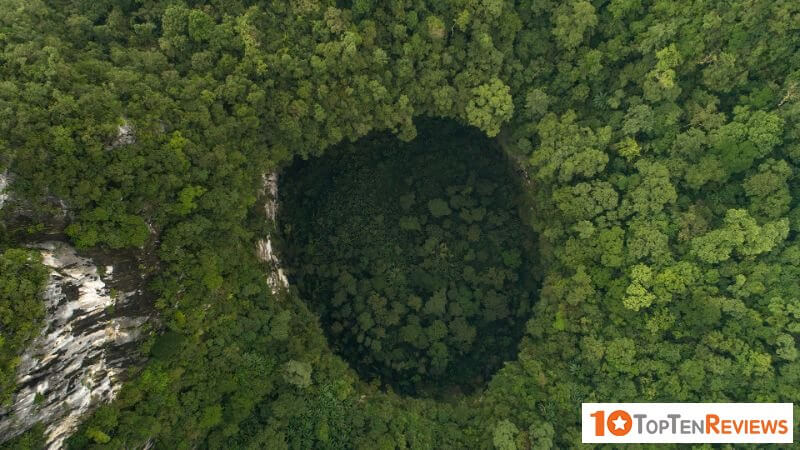
Map of Son Doong cave
Entrance to Son Doong Cave: "Although these are extensive caves, they are almost invisible until you are right in front of them," commented one explorer. Hunters discovered them when they saw the wind blowing from the underground caves. If you are a photography enthusiast, then this is great.
The road from the entrance to the cave has a steep slope, it is complicated to go down, and you have to go along a fast-flowing underground river to go deep into the cave.
The cave section has a width of about 92m, with this nearly 244m wide arch in Son Doong can accommodate a 40-storey building in New York, USA. The structures here are larger and more majestic than any human imagination. The most comprehensive place of Son Doong cave was presented by Mr. Howard Limbert that three large planes can fly together comfortably.
Son Doong Cave formed about 2-5 million years ago when river water flowed through the limestone area buried along a fault line. The water eroded and scraped a massive tunnel in the ground under the mountain range. In soft rock, the ceiling collapses to form holes, long into a giant cave arch. There is a tremendous, straightforward, and deep "pool" in the cave.
A section of the roof of Son Doong cave collapsed many years ago, creating conditions for light to come in, luxuriant trees to grow, creating a magnificent forest in the heart of the cave. Explorers named this place the Garden of Eden.
The Garden of Eden has a vast area, including many plants, ample water surrounded by clusters of forest trees and plants of all kinds, diverse ecosystems of the tropics, especially vines climbing crisscrossed across the rock.
This is the ideal home for many plants and natural creatures. Somewhere you will hear birds chirping under the forest. The sound of water flowing by the ravine is impressive and majestic, a vast area.
In the Garden of Eden area, expedition scientists discovered three new species of millipedes, woodlice, and another crustacean. In the forest, there are nearly 400 species of plants, in which there are birds outside migrating to live very beautifully, and from above the cave of Phong Nha-Ke Bang National Park, you can see the hills. The vestiges of the war are still imprinted over time. The bomb craters in that war have become fish ponds. The green fields, fertile lands, mountains and rivers, and fields make the attractive landscape accompanying it can evoke a peaceful and peaceful countryside scene.
Wherever there is sunlight and wind, the green color of life in Son Doong cave is an entirely different world from the naked, pitch-black darkness found in most other shelters.
The pearl cave in the terrace lake is dried, has unbelievable beauty. In the natural structure over thousands of years, calcium crystals have encased small grains of sand to form rare "pearls." This priceless "Pearl Collection" is located near the Garden of Eden in Son Doong Cave.
A giant stalactite cliff about 70m high protruding at a depth of more than 6km under Son Doong cave is named the "Great Wall of Vietnam." The wall is known as the Vietnam Wall or the Great Wall of Vietnam. Behind Vietnam, the wall is the second entrance to the cave.
Come to Hang Son Doong to explore the most magnificent cave in the world. You will be immersed in the pristine natural forests, birds chirping, murmuring streams, rustling winds of the World Natural Heritage Phong Nha-Ke Bang National Park combined with activities. For example, you can camp, fish, swim in creeks and observe langurs, visit Doong village, a highland town, feel the still, very wild activities of the ethnic people in the heart of the heritage, and enjoy the specialties of the people. The locals are really an exciting experience never to forget.
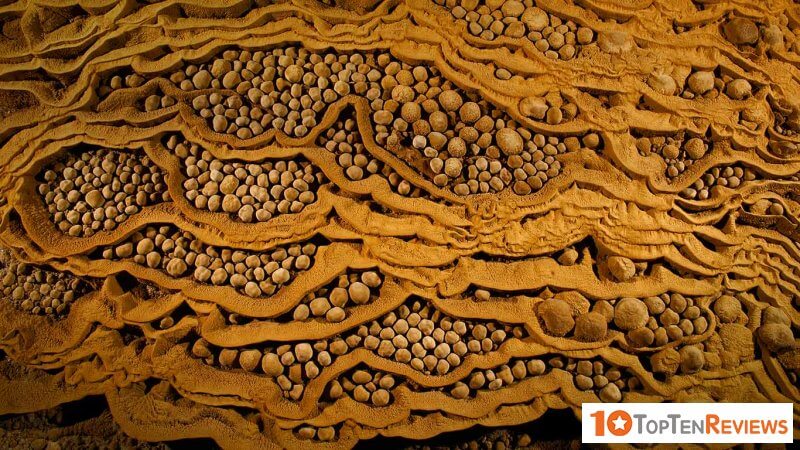
The most desirable destination in the world
On January 4, 2019, Deputy Director of Quang Binh Provincial Department of Tourism Dang Dong Ha confirmed that Lonely Planet is a foremost reputable magazine about guiding and providing information for listed tourists. The 5 most desirable travel destinations worldwide in 2019.
In this list, Son Doong cave in Quang Binh province, the world's largest cave, is ranked third, after the Inca trail to Machu Picchu in Peru and the Burning Man cultural, music, and art festival in Nevada.
To make dreams come true, Lonely Planet Magazine advises travelers to keep their calendars in mind to book now to conquer the world's most dream destinations in 2019.
In particular, Son Doong, with the incredible depth of the world's largest cave, will attract all those who want to have a real adventure tour.
Deputy Director of Quang Binh Department of Tourism Dang Dong Ha added that Son Doong cave was voted by a sizeable prestigious magazine as one of the 5 most desirable destinations in the world in 2019 is really a miracle. The information is very encouraging, making an essential contribution to the promotion and introduction of the destination, the image of Son Doong cave, and the tourism of Quang Binh province and Vietnam to the world.
Quang Binh Department of Tourism cooperates with related units to organize activities, promotion, advertising, and organizing discovery and experience of destinations for tourists to ensure safety and quality to deserve to be a destination of choice for travelers.
The Quang Binh Department of Tourism has implemented many major promotional programs with global effects, such as promoting Quang Binh tourism through cinema in Hollywood.
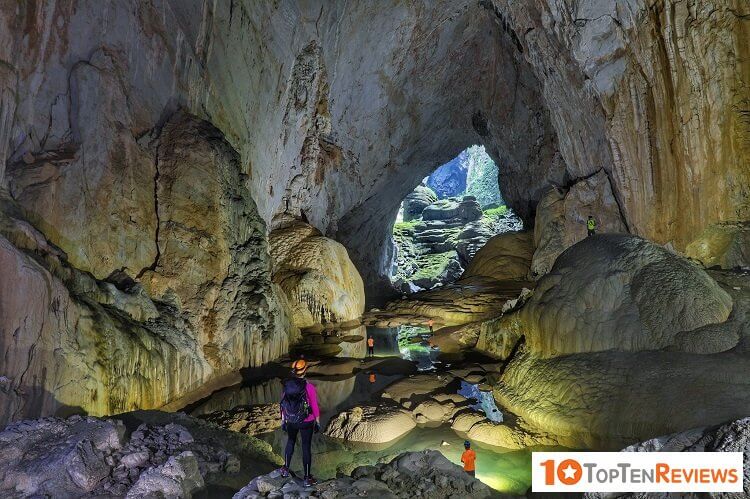
Lonely Planet - a major reputable magazine about guides and information for tourists, has listed Son Doong cave in the list of the 5 most desirable tourist destinations worldwide in 2019.
Significantly, the program explores a 600m long underwater passage that has never been explored inside Son Doong cave. Its aim is to find the way from the existing cave system to a nearby cave (Thung cave) with the participation of the cave diving expert who participated in the rescue operation of the "Wild Boars" football team in Thailand gave unexpected results.
According to the Quang Binh Department of Tourism, experts have made the initial assessment that when reaching 25m, the underground river inside Son Doong cave will run across to connect with the underground river inside Thung cave. However, the reality is entirely different.
When the expert team measured the depth of the underground river with a wire, the bottom of the underground river beside Son Doong cave was 93m. It is difficult to use a conventional compressed air scuba tank to dive at this depth, so diving experts have to search for underground cave ceilings at a depth of 40-50m.
Experts have dived at 77m to find the way to Thung cave but have not seen it. Shortly, experts will continue to dive at a depth of over 100m to survey.
During the survey, experts used automatic mapping of the survey area... Through this survey, the experts discovered the underground cave system at a depth of 60m. The deeper the underground cave system, the more open it wide. This depth was already deeper than sea level at the diving site.
With this discovery, Son Doong cave continues to be a mystery to cave experts and scientists. The depth of Son Doong cave increases to more than 500m from the mouth of the cave until the last part has not been fully explored.
The surreal beauty of Son Doong cave has attracted major television companies worldwide to organize reality TV shows here and Phong Nha-Ke Bang.
Telegraph voted Son Doong cave as one of the 11 best tourist destinations globally; 3 out of 8 photos of the most beautiful cave in the world published by National Geographic are about Son Doong cave.
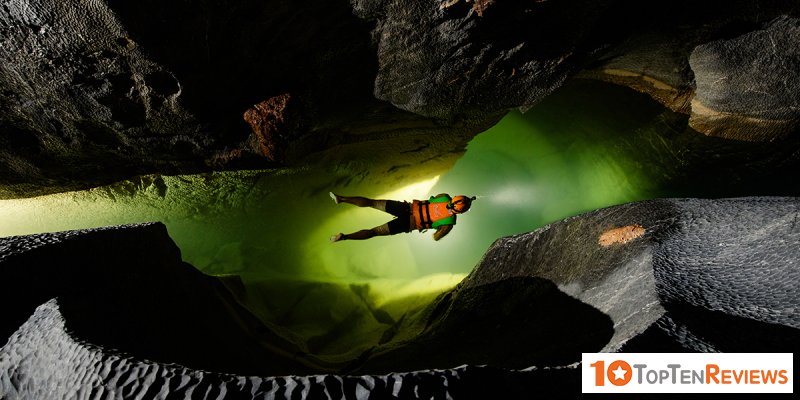
The birth of the Son Doong expedition
After being announced as the world's largest cave in 2009, Son Doong cave has been put into operation in adventure tourism since 2013.
To best protect and preserve the ecosystem in Son Doong Cave, the People's Committee of Quang Binh province decided to choose Oxalis Adventure as the only unit to organize Son Doong cave exploration tours. It gets the support of experts member of the British Hang Gia Cave Association.
The first tour took place on August 1, 2013. Each time is an average of 10 visitors and camping for 4 days and 3 nights inside Hang En and Son Doong.
The world's leading experience: Son Doong Exploration will take you to discover the mysterious world deep in the most extensive cave on the planet, learn about the separate ecosystem in the shelter or admire the giant stalactite formations giant.
With limited exploitation of the number of participants, the number of people who have successfully conquered Hang Son Doong is now even much less than the number of people who have ever stood on Mount Everest.
The People's Committee of Quang Binh province identified the Son Doong expedition tour, the world's largest cave, as a type of world-class adventure tour. European standard.
Each tour has 10 guests but requires up to 30 waiters, including cave experts, guides, safety assistants, chefs, and porters carrying a total of about 600kg of equipment in and out of the cave. Everything brought in must be taken out of the cave, including human waste.
Since Son Doong officially became a tourist destination for tourists who are passionate about conquering and exploring, the tour to explore the magnificent caves of Quang Binh has been fully booked until 2021.
Although foreign visitors to Son Doong are making up a large number of tourists, the percentage of Vietnamese tourists has also increased significantly, about 25% in 2018.
In addition, Son Doong also has countless untapped mysteries, hidden with spectacular development potential in the future.
Son Doong tour is currently priced at 3,000 USD/person and only accepts up to 10 guests per tour to ensure the safety and conservation of the cave. Each group of 10 guests will have 22 porters carrying luggage and food throughout the journey, 5 safety assistants to support guests, an international guide, a British cave expert, two chefs, and an inspector forest Park./.
